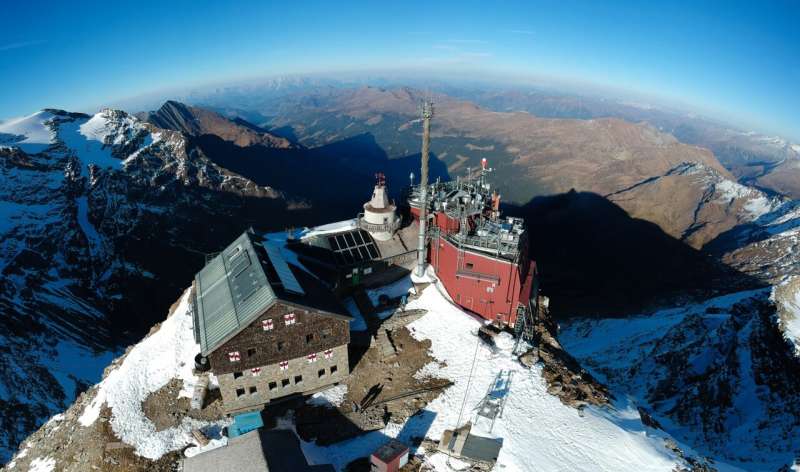View over the pristine high Alps from Sonnblick Observatory. Credit: ZAMG-SBO/GernotWeyss
A team of researchers have found nanoplastics at the pristine high-altitude Sonnblick Observatory in the Alps. This is the first time that nanoplastics have been found in this area. The researchers were originally looking for certain organic particles, but found nanoplastics by chance, discovering a new analysis method for detecting nanoplastics in the process. The research is published today in Environmental Pollution.
The researchers were looking for organic particles by taking samples of snow or ice, evaporating them, and then burning the residue to detect and analyze the vapors. "Our detection method is a bit like a mechanical nose. And unexpectedly, it smelled burning plastics in our snow samples," lead researcher Dušan Materić explains. The detector found the smell of several types of plastic, mostly polypropylene (PP) and polyethylene terephthalate (PET).
Shocked and surprised
The detected plastic particles turned out to be less than 200 nm in size, about one hundredth the width of a human hair. That is significantly smaller than plastic particles detected in previous studies. "With this detection method, we are the first group to quantify nanoplastics in the environment," says Materić. "Since the high Alps are a very remote and pristine area, we were quite shocked and surprised to find such a high concentration of nanoplastics there." The results suggest that in addition to microplastics, there might be as much nanoplastics present in these remote places.
Sonnblick Observatory in the Austrian Alps. Credit: ZAMG-SBO/GernotWeyss
Transported by air
"We were quite gripped by these findings," Materić continues. "It's highly unlikely that these nanoplastics originated from local pristine Alpine areas. So where did they come from? We completely turned around our research project to study this further." The researchers found a striking correlation between high concentrations of nanoplastics and winds coming from the direction of major European cities, most notably Frankfurt and the industrial Ruhr area in Germany, but also the Netherlands, Paris, and even London.
"Advanced modeling supported the idea that nanoplastics are indeed transported by air from these urban places," says Materić. "That's potentially alarming, because that could mean that there are hotspots of nanoplastics in our cities, and indeed in the very air we're breathing. We are currently studying this in more detail." Since working on the current publication, Materić has already received an additional grant of 50,000 Euros from NWO, the national research council of the Netherlands, to study the size distribution of nanoplastics in indoor, urban and rural air.
More information: Nanoplastics transport to the remote, high-altitude Alps, Dušan Materić, Elke Ludewig, Dominik Brunner, Thomas Röckmann and Rupert Holzinger, Environmental Pollution, 1 November 2021. DOI: 10.1016/j.envpol.2021.117697
Journal information: Environmental Pollution
Provided by Utrecht University Faculty of Science

























